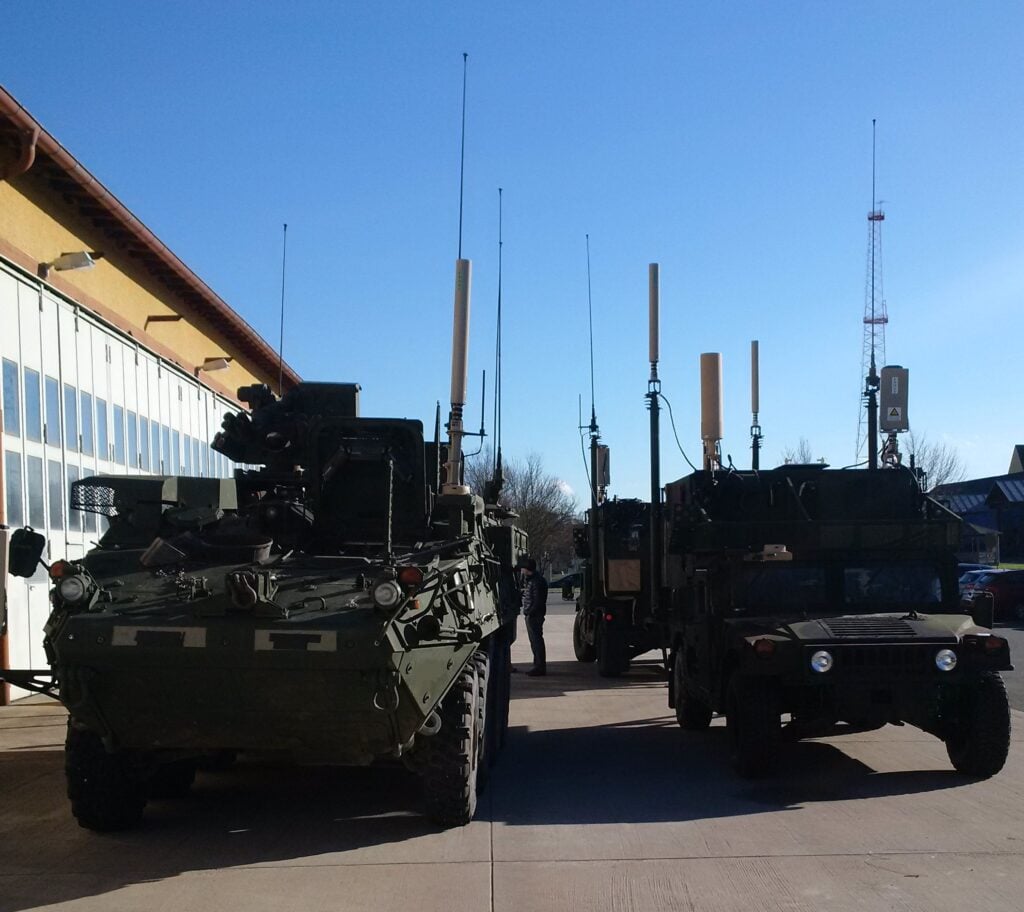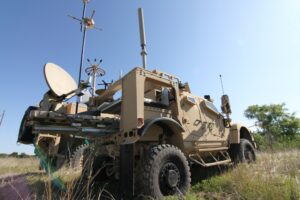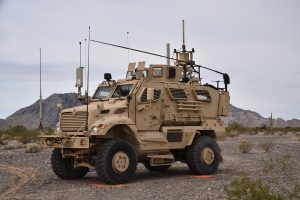Digital Arsenal: Army Inches Forward On Electronic Warfare
Posted on

Army 8×8 Stryker and Humvees, all mounting variants of the hastily-fielded Saber Fury electronic warfare system — note the veritable forest of antennas.
The Army wants to jam, spoof and hack enemy electronics with such subtlety the target doesn’t even realize what’s going wrong. That takes both high-tech equipment and highly trained personnel to use it.
But the Army largely disbanded its electronic warfare corps after the Cold War, and the rebuilding takes time. The service is moving step by step, through a series of urgent expedients, field experiments, and “proto-prototypes,” towards its ultimate goal: combining electronic warfare, cyber warfare, and signals intelligence into a new form of digital warfare, a key part of the future combat concept called Multi-Domain Operations.
[Click here to read Part I of this story, Digital Stiletto: Army Pursues Precision Electronic Warfare]

Prophet signals intelligence vehicle.
The Army’s official acquisition Program Of Record (POR) here is TLIS: the Terrestrial Layer Intelligence System. That name reflects TLIS’s origin in signals intelligence, originally as a replacement for the existing tactical SIGINT system, Prophet. But then the Army decided TLIS should absorb the ground-based version of its Multi-Function Electronic Warfare system. (A drone-mounted EW pod, MFEW-Air, continues as a separate program).
That alarmed traditional EW officers, who saw a hostile takeover of their already tight budget by the more prestigious and better-funded SIGINT corps. But there’s a logic behind it. Signals intelligence and electronic warfare have always required a similar set of sensors to detect and analyze enemy transmissions. (In fact, the Russian army combines SIGINT and EW in the same units). What’s more, as technology evolves, it becomes more flexible: Instead of having to build a specific analog system for each mission, the same digitally controlled transmitter/receiver module can be used to eavesdrop, communicate, or attack, depending on the software.
When Russia’s invasion of Ukraine — and its brutally effective jamming of Ukrainian military communications — made clear how important electronic warfare was at the tactical level and made it an urgent issue for the Army again, the service initially had to make do with the hardware it had. That was large numbers of short-range jammers developed to disable radio-detonated roadside bombs, primarily a vehicle-mounted system called CREW Duke. (That’s an awful nested acronym for Counter-RCIED Electronic Warfare, RCIED in turn standing for Remote-Controlled Improvised Explosive Device).

An Army civilian assembles a DUKE jammer to disable roadside bombs
But thanks to the flexibility of modern digital electronics, it proved possible to modify CREW for longer-range electronic warfare against a wider range of targets. With upgraded software, antennas, and amplifiers, the souped-up CREW was designated Saber Fury and fielded urgently to frontline units, starting with the Strykers of the Germany-based 2nd Cavalry Regiment. (See the photo at the top of this story for some examples of this equipment installed on Humvees and Strykers).
The Army also produced an even higher-power version of the core CREW Duke system and installed it on a heavier vehicle, an MRAP truck. But only a handful of these Electronic Warfare Tactical Vehicles (EWTVs) were built, primarily for experiments and training.
Instead, the Army decided to move beyond upgrading CREW to entirely new technology, mounted on the much larger and better-armored 8×8 Stryker: the Tactical Electronic Warfare System. (A stripped down “light” version with sensors but no jammer, TEWL, fits on an MRZR dune buggy). TEWS “provides a better sensing and electronic attack capability, [plus] automated signal processing, which is going to lighten the burden for the operator,” said Col. Mark Dotson, the Army’s “capability manager” for EW, in an interview.

Army Electronic Warfare Tactical Vehicle (EWTV)
TEWS also has a “rudimentary” capability to launch wireless cyber attacks, Dotson said, making it a first step towards integrating electronic and cyber warfare.
The next step was to add signals intelligence to the mix. That came with a vehicle called TSIG — basically a modified TEWS fitted with cutting-edge SIGINT tech — of which the Army built three to use in experiments and exercises. “That’s where electronic warfare and SIGINTers can first work together in one environment and each do their own job at the appropriate classification level on one system,” Dotson told me.
TSIG is a “pre-prototype” for the final TLIS system, which will be manned by both EW and SIGINT personnel working side-by-side. The exact mix, he said, will vary with the mission.
The Army hasn’t decided what technologies to use for TLIS or what vehicle to mount them on — the official requirement won’t be finalized until next year, with fielding expected around 2022-2023. But the tentative plan is for a single TLIS section to consist of two identical vehicles and seven personnel: three SIGINT and four EW.
Of course, making this all actually happen requires both funding and manpower but electronic warfare, cyber warfare, and signals intelligence aren’t listed among the Army’s Big Six modernization priorities. And none of the service’s eight high-level Cross Functional Teams are focusing on them.
Of course, the ability to defend against enemy cyber attack, electronic warfare, and SIGINT eavesdropping is a major concern for the teams working on the Army network (Priority no. 4 of the Big Six) and on jam-proof alternatives to GPS. But the ability to attack isn’t part of any Cross Functional Team’s portfolio.
“EW…we’re prioritizing it outside of the CFTs,” the Army’s deputy chief of staff for resources (G-8), Lt. Gen. James Pasquarette, said at a conference in June. Electronic warfare programs were not among the 186 cut or canceled to help fund the Big Six, he said, and indeed EW saw some increases. The current five year budget plan proposes $3.4 billion for electronic warfare programs over 2020-2024.
There will be more funding to come, Pasquarette promised. But it’s in the forthcoming 2021 budget, which he couldn’t discuss. Stay tuned.
Subscribe to our newsletter
Promotions, new products and sales. Directly to your inbox.
